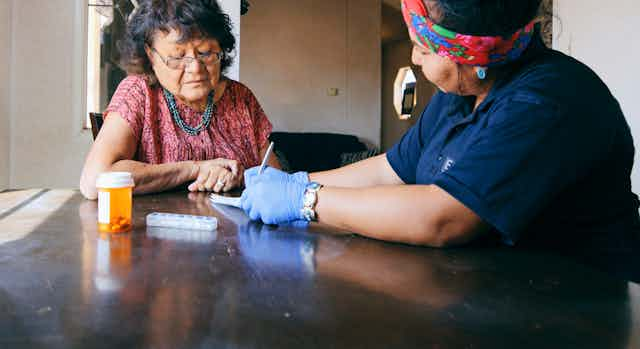The Research Brief is a short take about interesting academic work.
The big idea
Medicaid, which provides low-income Americans with health insurance coverage, currently excludes large numbers of adults over 65 with social, health and financial profiles similar to those of people the program does cover. Based on a study we conducted, we determined that if strict eligibility rules for Medicaid were changed to help cover such people, from 700,000 to 11.5 million people over 65 would be newly eligible for the program.
We analyzed data from the 2018 Health and Retirement Study, a large national survey of older adults conducted by the Institute for Social Research at the University of Michigan every two years, to determine how using five different financial eligibility criteria would increase the number of older adults who would qualify for Medicaid and what they would look like.
Depending on which rules were changed, we would expect to see one of the following scenarios:
If the government switched from the official poverty measurement Medicaid uses – currently an annual income of US$14,580 for one person – to its more accurate supplemental one, which takes taxes, health care costs and certain other expenses into account, about 700,000 more older Americans would get Medicaid coverage.
If the amount of assets that people can have were in line with other programs, such as the Medicare Savings Plan, an additional 1.4 million people would qualify. Medicare Savings Programs help pay Medicare costs for older adults with limited income and savings.
If Medicaid stopped considering assets altogether, an additional 2 million would qualify.
If the income eligibility threshold were higher, equal to 138% of the federal poverty level, it would mirror how the government determines whether adults under 65 can get Medicaid, and 4.7 million more older people could be covered by the program.
A measure that’s increasingly used to evaluate the vulnerability of older adults is the Elder Index, which takes into account basic expenses like housing, health care and food. People over 65 with incomes that fall above the official poverty line but below the Elder Index are considered to be financially vulnerable. If the government used the Elder Index as a basis for Medicaid eligibility, 11.5 million additional older adults would qualify for the program.
Unless the government adopted the Elder Index approach, most of the additional enrollees in these scenarios would have poor health and few financial assets.
Why it matters
The extra Medicaid enrollment would be in addition to the 7.2 million older people already in the program.
All the people who would potentially qualify under these different eligibility standards are unable to shoulder even modest long-term care costs without public assistance aside from their Social Security benefits – one of the largest risks facing the over 70% of older adults who will have such needs. This risk persists in part because Medicare does not cover such needs.
Low-income adults who are excluded from Medicaid under existing criteria also face high health care costs that contribute to their financial insecurity. Researchers found that 1 in 5 Americans over 65 skipped, delayed or used less medical care or drugs because of financial constraints.
Increasing the number of low-income older people with both Medicaid and Medicare coverage would reduce their out-of-pocket health spending. That would make it easier for them to hang on to their modest savings and also enable them to expand their own caregiving options should they have high medical or long-term care expenses as they age.
What still isn’t known
Increasing the number of older people with Medicaid coverage would require more government funding, although the degree of extra spending would depend on which rules the government would change.
Based on the average cost per Medicaid user, our rough estimates suggest that the cost of expanding Medicaid coverage for older people in the first four of the five scenarios we considered would range between about $8 billion and about $51 billion per year. We could not provide an estimate for the Elder Index scenario because the profile of individuals brought into the program would be substantially different from the current Medicaid users, so the per-person costs would be harder to predict.
Accurately estimating these costs and the potential benefits for families and communities that would come from these changes would require additional research.

